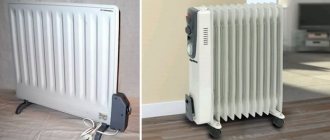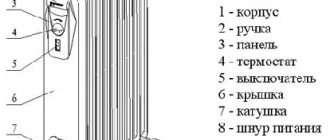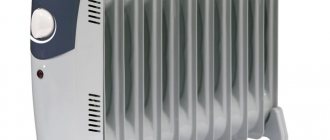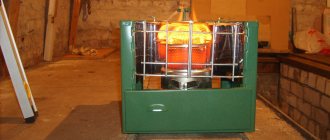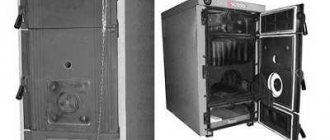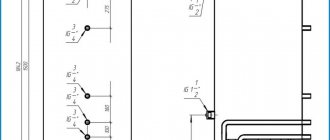Good day! Let's discuss - convector or oil heater - which is better.
In the house of one of my distant relatives (living outside Russia) last year, just before the season, the central heating was cut off. It happened unexpectedly - housing and communal services employees simply came to his house with an oil heater and offered to survive the winter like this. Is it a good joke to heat 60 square meters of space with one fireplace? Naturally, he no longer had time to design and install a gas system. I decided to endure it and buy something electric. If you suddenly face a similar choice, read this article.
Operating principle of oil heaters
I have already described how convectors operate in previous materials. An oil radiator works on the principle of any electric fireplace: fuel (in this case, oil), when heated, transfers heat to the metal body, and it, in turn, to the environment. That is, the device first heats itself, and only then the room.
Outwardly, such a device resembles a classic battery with sections - the more of them, the hotter the room will be.
What else you need to know about the oil heater:
- The unit was created 20 years earlier than convectors.
- Programmed to maintain optimal temperature in an apartment or office.
- A ceramic or, less commonly, metal heating element is used as a heating element.
Modern models are equipped with additional functions such as a timer and fall protection.
Summary comparison table
For clarity, we summarize the above analysis in a table.
Table 1. Comparative characteristics of the converter heater and oil radiator expressed in numbers.
| Characteristics | Convector | Oil heater |
| Price | 4 | 5 |
| Life time | 5 | 3 |
| Efficiency | 4.5 | 5 |
| Room heating speed | 5 | 4 |
| Ease of use | 4.5 | 5 |
| Design | 4.5 | 3.5 |
| Safety | 5 | 4 |
| Additional functions | 4.5 | 5 |
| average rating | 4.63 | 4.31 |
The table provided, although not 100% objective, allows you to give a hint when answering the question: a convector heater or an oil heater, which is better to choose. Naturally, preferences may differ. But there are situations when the choice is obvious.
We're racing against each other
Most consumers are prejudiced against heating devices powered from the network. This is understandable - the price of electricity in the Russian Federation is constantly growing. That’s why the speed of heating the room and the option to maintain heat are so important. Then there will be a chance to save on electricity.
Convector heaters begin to heat up almost immediately – after 5-7 minutes. And models with a built-in fan - instantly. This is due to the fact that the unit has no parts that need to be heated - it gives off heat as soon as the air in the room begins to circulate.
Oil radiators are inferior in speed. Some models, at an outside temperature of -10°C, only heat themselves for the first half hour. More modern ones require 15-20 minutes. But it’s still not fast compared to convectors. But keep in mind one nuance - the slower the oil heater heats up, the slower it cools down, continuing to release heat into the atmosphere.
Still, many consumers prefer to deal with convectors.
Which one heats better and faster?
The prevailing quality of oil heaters over convection units is their high heating temperature. But the latter begin heating the room instantly (oil radiators take a long time to heat the oil) and create a favorable microclimate for the space.
The maximum heating area with an oil radiator is 30 m². The performance of convectors allows them to heat a room of 100 m² or even more.
Important! Another important advantage of the oil unit is that it emits heat after shutdown.
Heating area
How often do I hear from clients the question: “Is one device enough for me?” I immediately ask in response: “Do you want to save money or keep warm?” If the first option, one fireplace is quite enough.
Both oil and convector heaters are capable of heating a room of approximately the same size. But it would be a mistake to assume that one fireplace = one room. Firstly, a lot depends on the power of the device. Secondly, it’s better to navigate by footage. For example, you have a 1 kW device. It is enough to heat 10-12 sq.m. So better plan your purchases, taking into account the features of your own home.
Convectors or radiators
Any specialist will tell you that a convector and a radiator are completely different devices. Both heat the room, but they do it in different ways.
Radiators produce heating by radiating heat that emanates from their surface. The mechanism of operation of the convector is completely different. Cold air is heated by the plates, rises, cools there, falls and is heated again in the convector plates.
Radiators are traditional and their design is well known. It consists of individual elements, the quantity of which determines the power of the device.
Radiators help to heat the room evenly, they retain heat longer and are easier to care for. They have tangible benefits. This:
- Efficient heat dissipation.
- Economical operation.
- Affordable price.
Convectors are heating panels that can be used for basic heating where the use of radiators is not possible. But most often such devices are used as an additional source of heat. It’s also easy to list the advantages of such a choice:
- Take up less space than radiators.
- Safer to use.
- They can be installed so that they are not visible - for example, built into the floor or wall.
Taking into account the characteristics of each heat source, you can easily make your choice.
Dimensions and appearance
When purchasing a heater for a country house, few people care about the compactness of the device - as long as it copes with the task assigned to it. Residents of small apartments are forced to take into account the size of fireplaces so as not to steal functional space from their home.
In terms of compactness and ease of placement, wall convectors win - they are flat and lightweight. Floor-standing ones won’t take up much space either. Oil radiators are more bulky and cannot be attached to the wall. In addition, not everyone likes the mass of such devices - when a heater weighs 20 kg, difficulties arise when moving from room to room, even with wheels.
As for the design, here I also give sympathies to convectors. They are laconic, discreet and fit into any interior. Moreover, wall-mounted models can be hidden behind mesh decorative grille panels.
Oil fireplaces are not distinguished by grace and beauty. Most of them look like a standard Soviet heater. But if you need to heat an average room, keeping it warm, and appearance is not important to you, then a radiator will be the best choice.
Convector heaters
They differ from oil radiators in the shape of the body - they are flat and smooth. It has a room thermostat, thanks to which the room maintains the desired temperature.
Simple convector heaters in a classic design.
Unlike oil-type heaters, which are mainly floor-mounted, convector radiators are mainly mounted on walls. But there are also floor-standing models - they usually have wheels for movement.
A convector that has fastenings and can be either hung on a wall or installed on wheels.
Skirting convectors can be from 15 cm in height and 1500 cm in length.
Oil-type heaters radiate heat. Convectors have minimal heat radiation - only from the front panel. And the heating of the air occurs due to the exchange of heat between cold and hot air masses. In this case, there is a constant movement of air along the surfaces of the heater.
Convectors do not make any noise; their operation is based on a natural process - air convection. They heat the room quickly and evenly. Mounting the device on the wall is easy and simple, and if desired, you can install it on the floor. There are convector heaters for both home and office, commercial or industrial premises.
In a convector device, air moves, moving to different heights. Hot, more rarefied air flies upward, towards the ceiling, and heavy, cold air tends downwards, towards the floor. If convection occurs correctly, then flows of air masses constantly arise, heating the room.
This is how air masses move through the process of convection.
The device consists of the following elements:
- Convection chamber (heater body);
- Heating element built into the housing.
Convector heater with front cover removed.
During operation, cold air entering the convector is heated by a heating element. The air becomes lighter, it rises and exits through the upper blinds. Well, a new portion comes to replace the cold air in the room that has gone up.
The heated air has a temperature set on the thermostat. It turns the heating element off and on. The operating efficiency of this device is very high. The slots located on the front panel are designed to allow hot air to escape. So that it does not move straight up, but heats the floor and walls, the blinds for its exit are directed downwards. The air does not come out immediately, but accumulates inside and receives excess pressure. After this, it exits the device in a horizontal direction.
Convector heater thermostat.
Since the heating element is specially fixed in the housing, you don’t have to worry about grounding. After all, the heating element does not have contact with the metal of the body - between them there are stops made of special heat-resistant plastic. And the design of the device is made in such a way that the heat in the room is distributed evenly. This achieves coziness and comfort.
For those who cannot decide whether to buy a convector or oil heater, it would be useful to know about the advantages of convector heaters:
- These devices are fireproof and meet the requirements of European standards.
- Such heaters placed in each room and combined into one network can create a modular heating system. At the dacha or in a country cottage, it can be used instead of a boiler, which is expensive and requires the installation of numerous heating pipes,
- Thanks to the electronic thermostat and various operating modes, you can save a lot of electricity.
Electronic control system and on/off timer.
Fire protection
When buying an electrical appliance, you should definitely find out which is safer – a convector or a radiator. In principle, both types of heating devices are designed with fire protection, and some models automatically turn off if accidentally dropped. There is even a “child lock” option, but only on advanced electronically controlled convector fireplaces.
Do not discount such a parameter as the condition of the wiring. Often, fires happen precisely because of old contacts, and not because the device is malfunctioning. I strongly recommend that anyone planning to switch to a convector heating system install an additional line - these devices greatly increase the voltage. For an oil fireplace, a regular outlet is sufficient.
Also keep in mind that dust often gets on the heating element of the convector - this can be heard from the burnt smell when the device is turned on. Now imagine that this is not dust, but some larger garbage, for example, scraps of paper carefully placed behind bars by a restless child. Guess how many times the fire threat will increase? With an oil radiator, such a danger does not arise, since the heating element is hidden under the body and no foreign object can get there. Reading reviews, I learned that you can even dry things on such a device and nothing will happen to it. Whereas you cannot hang anything on the convector.
On the other hand, oil devices heat objects nearby. For example, if the fireplace is located close to a table or cabinet, there is a risk of deformation of the surface of the latter. In addition, the housing becomes very hot during operation, which can lead to burns. This will not happen with a convector - it does not heat the surface, and it itself remains practically cold.
Conclusion: the default fire safety of these devices is the same, but if used carelessly there may be a risk of fire or burns.
Which convector to choose
Which device should you choose?
You can find different types of convectors on sale. In order to choose the right model, you need to take into account several indicators:
- Cost of the device.
- Device type.
- Device power.
- Design safety.
For water systems, special heating convectors are selected, steel, having a rather complex design. They are based on a volumetric heat exchanger. It connects to the main hot water supply system and effectively heats the room.
The heat exchanger is made of pipes cast from an alloy of non-ferrous metals. But it is the design of the casing itself that ensures good heat transfer, controlling the rational use of energy.
Modern technologies make it possible to produce steel convectors with a protective and decorative coating. Powder coating helps create a wide variety of color schemes, so the decorative value of this option is obvious.
Gas convectors heat the air in the room due to the combustion of gas, which occurs in a separate chamber. At the same time, air is taken in and combustion products are removed. It should be noted that such devices are much safer from an environmental point of view than conventional gas stoves.
There is no water circuit in a gas convector, so there is no need to route pipes around the room, connect pumping equipment, or install fittings. Therefore, this heating option is often chosen for country houses.
Water convectors
For the structures described, copper casings are often used. This convector is distinguished by the highest technical characteristics and unique design, so it harmonizes perfectly with any interior.
Electric ones practically do not burn oxygen in the room. And this has a beneficial effect on human health. They do not have a metal spiral, instead of which there is a finned tube. The case is never hot. Most devices are equipped with an additional overheating protection system.
The thermostat will automatically turn off the device if the temperature exceeds the set norm. As a result, the device works intermittently, which helps save energy consumption and extend its service life.
In terms of consumer parameters, electric convectors are significantly superior to their competitors listed above, so it is no coincidence that they have recently become very popular heating systems.
As you can see, you can choose a convector based on your own wishes and technical features of the devices. All modern radiators, convectors and radiators are very effective. They help increase the degree of comfort and create more favorable living conditions during the cold season, so you can’t do without them.
Saving is everything
Well, not everything, of course, but this is a very important parameter. Agree, any consumer of two devices will choose the energy-saving one if both heat equally.
So what is more economical - oil or convection? Oil-based devices take longer to gain momentum to release heat. As soon as the unit warms up, it already “eats” approximately 500 W (depending on the power of the model). It turns out that you are paying extra money for emptiness. Although, if you close the room and turn off the thoroughly hot device, it will maintain heat for about half an hour.
But isn’t it easier to take a convector that will start heating immediately, reducing electricity consumption by 25%? Please note that this is only relevant in the case of conventional models - if there is a fan near the fireplace, the savings disappear.
Conclusion: convectors are faster and therefore use energy more sparingly. But only in the absence of additional functions.
What is better to choose for your home?
On most points, the convector has the advantage. But this does not mean that the oil cooler is hopelessly outdated and should not be used. It costs less, but in terms of functional parameters it is quite good, so it remains in demand. Although, if you compare the cost of the devices with the service life, then the convector turns out to be a more profitable purchase.
An oil heater is good for offices, work spaces, and garages, where the attractiveness of the interior is of secondary importance. The purchase of devices is relatively inexpensive for the company. In offices, an oil radiator efficiently and evenly heats spacious rooms without creating dust.
In residential areas, it is better to use a safe, stylish and non-bulky convector. It is also suitable for a dacha, which the visiting owners need to quickly warm up.
Your personal comfort and environmental friendliness
Since any heaters dry out the air, for an apartment with a small area it is better to choose the most gentle option. If you have allergies, do not lock yourself in a room with a convection fireplace running at full blast. Since air constantly circulates during the heating process, this prevents dust from settling. Consequently, it floats in the environment, and you will constantly inhale it.
Oil radiators do not circulate air, but can cause drafts due to uneven heating. For asthmatics or people prone to frequent colds, it is better not to use such a device.
To reduce the side effect of convection, use humidifiers or air ionizers, regularly do wet cleaning and ventilate the room. Sealed windows and tightly closed doors will help cope with drafts.
Advantages and disadvantages
Consumer reviews will also help us determine all the advantages and disadvantages.
- When using a convector, you can set the exact (literally down to a degree) temperature in the room and the automation will maintain it.
- The device body heats up no higher than 60 C, which is much safer than in the case of oil-based devices.
- With a little effort, you can connect several convectors into a common heating system. An oil-type heater works exclusively individually.
However, the convector also has its disadvantages:
- Customer reviews suggest that when using such equipment, a slight draft may occur in the room.
- The convector may not heat up rooms with high (above 3 m) ceilings very well. Warm air will “hang” under the ceiling and the device may not work efficiently enough.
- Natural convection can lead to increased movement of microorganisms and dust particles. This may be unpleasant for people susceptible to allergic reactions or diseases of the ENT organs.


